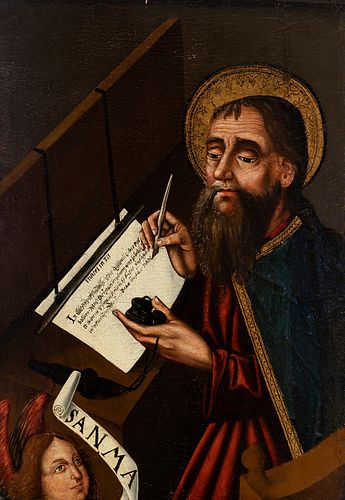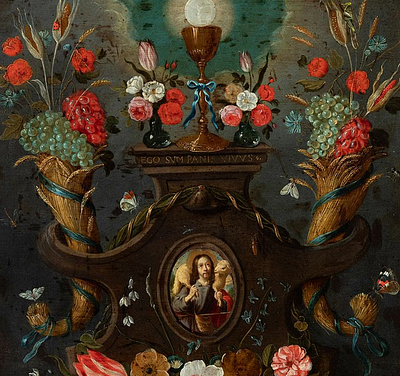Spanish school; first third of the 16th century. "San Mateo". Oil on panel. It presents repainting and old restorations.
Lot 3
About Seller
Setdart Auction House
Carrer Aragó 346
Barcelona
Spain
Setdart Subastas was born in 2004 and is currently the first online art auction in Spain with solidity, prestige and reliability guaranteed by our more than 60,000 users. Setdart has a young, dynamic and enterprising team ready to successfully manage the purchase and sale of art works through custom...Read more
Estimate:
EUR€4,000 - EUR€5,000
$4,210.53 - $5,263.16
Absentee vs Live bid
Two ways to bid:
- Leave a max absentee bid and the platform will bid on your behalf up to your maximum bid during the live auction.
- Bid live during the auction and your bids will be submitted real-time to the auctioneer.
Bid Increments
| Price | Bid Increment |
|---|---|
| EUR€0 | EUR€10 |
| EUR€200 | EUR€25 |
| EUR€500 | EUR€50 |
| EUR€1,000 | EUR€100 |
| EUR€3,000 | EUR€200 |
| EUR€5,000 | EUR€500 |
| EUR€10,000 | EUR€1,000 |
| EUR€20,000 | EUR€2,000 |
| EUR€50,000 | EUR€5,000 |
About Auction
By Setdart Auction House
Sep 21, 2021
Set Reminder
2021-09-21 10:00:00
2021-09-21 10:00:00
America/New_York
Bidsquare
Bidsquare : 21st September - ARAS JÁUREGUI Private Collection - Old Masters, 19th & 20th Century
https://www.bidsquare.com/auctions/setdart-auction-house/21st-september---aras-j-uregui-private-collection---old-masters-19th-20th-century-7429
Setdart Auction House sofia@setdart.com
Setdart Auction House sofia@setdart.com
- Lot Description
Spanish school; first third of the 16th century. "San Mateo". Oil on panel. It presents repainting and old restorations. Measurements: 62 x 43 cm. In this work we can observe Saint Matthew, accompanied by the winged man who identifies him in the Tetramorphos, alluding to his Gospel: his text tries above all to characterize Christ as King of the Jews and as the Messiah that the Scriptures prophesied, emphasizing his life as a man. Another example of this is the presence of the bundle and the pen, which the saint actively holds, showing himself to the viewer as the writer of one of the Gospels. The scene, which takes place in an interior, has very few elements that do not refer to the saint's iconography. These are the armrest of a chair and the table as a lectern on which he rests the scriptures. The scene has been conceived through diagonals, which do not follow a perspective based on the vanishing point, but rather dispense with it, focusing attention not so much on the representation of the saint, but rather on his holiness. Both the angular forms of the features and the folds of the clothing and the use of intense, complementary colours create a highly expressive scene. It is worth noting the detail achieved by the artist through a very short and precise brushstroke, so that all the wrinkles of the saint's habit can be appreciated. Saint Matthew the Evangelist was one of the twelve apostles chosen by Jesus and, according to Christian tradition, the author of the Gospel that bears his name. He is mentioned in the Acts of the Apostles, and also in the Gospel of Luke, under the name of Levi. Matthew is identified with a winged man or angel, a symbol of the tetramorph of the prophet Ezekiel. This association is due to the fact that his Gospel begins by reviewing the genealogy of Christ, the Son of Man and also the Son of God. Spain was, at the beginning of the 16th century, the European nation best prepared to receive the new humanist concepts of life and art due to its spiritual, political and economic conditions, although from the point of view of plastic forms, its adaptation of those introduced by Italy was slower due to the need to learn the new techniques and to change the taste of the clientele. Painting reflects perhaps better than other artistic fields this desire to return to the classical Greco-Roman world, which exalts the individuality of man, creating a new style whose vitality goes beyond mere copying. Anatomy, the movement of the figures, compositions with a sense of perspective and balance, the naturalistic play of folds, the classical attitudes of the figures soon began to be valued; but the strong Gothic tradition maintained expressivity as a vehicle for the profound spiritualist sense that informs our best Renaissance paintings. Although it is worth mentioning that there was still a medieval pictorial tradition, with aesthetic precepts really established in society, so that both schools coexisted and influenced each other, giving rise to an idiosyncratic and very personal style. This strong and healthy tradition favoured the continuity of religious painting, which accepted the formal beauty offered by Italian Renaissance art with a sense of balance that avoided its predominance over the immaterial content that animated the forms. In the early years of the century, Italian works arrived in our lands and some of our artists went to Italy, where they learned the new standards at first hand in the most progressive centres of Italian art, whether in Florence or Rome, or even in Naples.
- Shipping Info
-
In-house shipping available. Please inquire at admin@setdart.com.
-
- Buyer's Premium



 EUR
EUR CAD
CAD AUD
AUD GBP
GBP MXN
MXN HKD
HKD CNY
CNY MYR
MYR SEK
SEK SGD
SGD CHF
CHF THB
THB
















